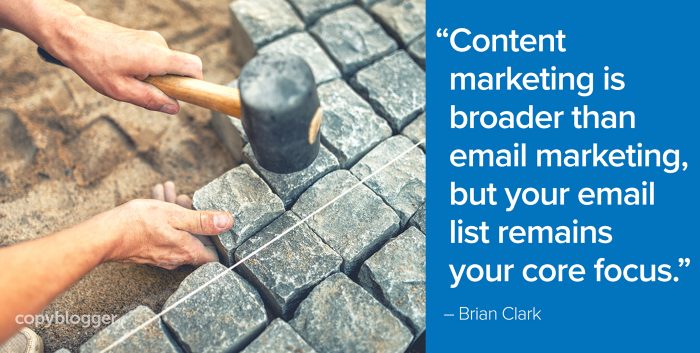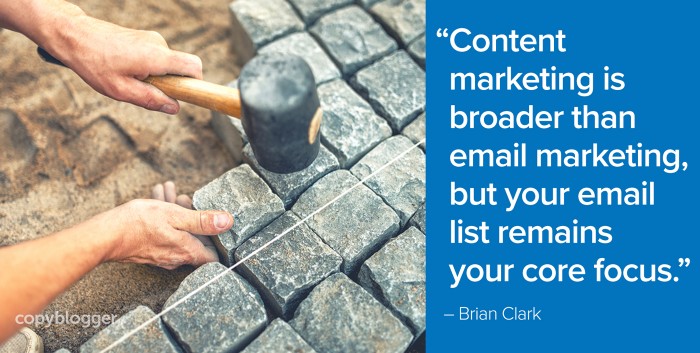Author: Brian Clark / Source: Copyblogger When we talk about content marketing strategy, all the discussions of heroes, journeys, and map

When we talk about content marketing strategy, all the discussions of heroes, journeys, and maps can seem a bit esoteric.
What does it look like in real life? And how exactly does it relate to email marketing?
Content marketing is a broader discipline than email marketing, but your email list is the core focus. In fact, the primary purpose of content that is distributed in other ways (social, search, ads) is to begin the email relationship.
So, let me walk you through an imaginary campaign that takes you from a documented strategy to a working funnel. I’ll use my site Unemployable as the stage for this particular campaign.
Please note that the documented portions of the strategy below are much more abbreviated than you would do for yourself. It’s just an illustration that will help you better understand how a documented strategy translates into real-world digital marketing.
Let’s take a look.
Objective:
Why are we pursuing this?
The business objective is to sell StudioPress Sites to people who want to start a new website.
Who:
In the “who” phase, we identify a single persona that we’ll keep in mind as we craft content.
This particular campaign will focus on freelancers looking to slowly move away from serving clients by shifting to a product-based business model. Our persona is a freelance writer named Penny.
Penny was thrilled to break away from the corporate marcom world and start her own business. She still loves the independence and flexibility, but some days the demands of her clients get to her. Instead of one boss, she answers to several demanding clients, each with different management styles and project requirements.
While she dreams of creating her first digital product, Penny dreads the thought of investing her time into something that doesn’t sell. She wants to develop a business based on her passion for cooking, not by teaching people to write. While she still wants to pursue the dream, her doubts about how to get started have kept her from taking even the first step.
Penny is a pragmatic and ethical person who is allergic to hype and incredible claims of internet riches. She is driven by a sense of fairness, and she holds disdain for those who take shortcuts at the expense of others.
Her worldview is that hard work is rewarding, and she often tells herself she should just be happy with the clients she has. Still, she’s willing to work a side hustle to pursue her dream, if only she could find the right path.
What:
In the “what” phase, we identify the sequence of information that the prospect needs to achieve her goal.
Now it’s time to identify the type of information that Penny will need to take action, and the order that will guide her step by step to transformation.
And since we’re trying to convince Penny to purchase a StudioPress Site, we’ll also need to communicate why it makes sense to do business with us over someone else.
Here are some broad considerations that we will turn into specific pieces of content and copy:
- Penny will need on-point content that addresses her desire to turn a passion into a business.
- The credibility of the source will be key to overcoming Penny’s skepticism.
- Given her freelance practice, Penny needs to know that she has the time to make this happen.
- She’ll need a way to validate her ideas and gain confidence.
- Penny wants to see specific examples of how people like her have succeeded.
- As a non-technical creative, Penny must be assured that she won’t be overwhelmed by technology.
- Finally, Penny must receive an offer that motivates her to take action now.
Now we can take these primary information points and map them out as a sequential journey. Or you can simply create a story outline that corresponds with each piece of content in the sequence.
How:
In the “how” phase, we take what we know about our prospect in order to best present the information.
Penny is a creative business person striving to become more entrepreneurial. Her no-nonsense attitude suggests a “just the facts” approach, but her need for case studies and real-life examples opens her up to persuasive storytelling.
Given her potential for skepticism, we’ll walk the line between “yes, this takes work” with constant reassurance that it’s totally doable. Characterizing the entire process as an act of creation will appeal to Penny’s sense of pride as a professional writer.
The tone can be somewhat snarky when it comes to “get rich quick” formulas, especially at the beginning. The goal is strongly differentiate the advice from the stuff business-opportunity people are looking for, and instead present this as a valid way to build a business that serves others just as it also provides value to the owner.
Here’s Penny’s experience
At this point, we want to summarize how Penny experiences the journey your content is taking her on. We’ve worked to empathetically understand her, and now we want to see the path from her perspective to better refine how we guide her through it.
While taking a short break from a client project, Penny sees an article on Facebook that catches her eye….

COMMENTS